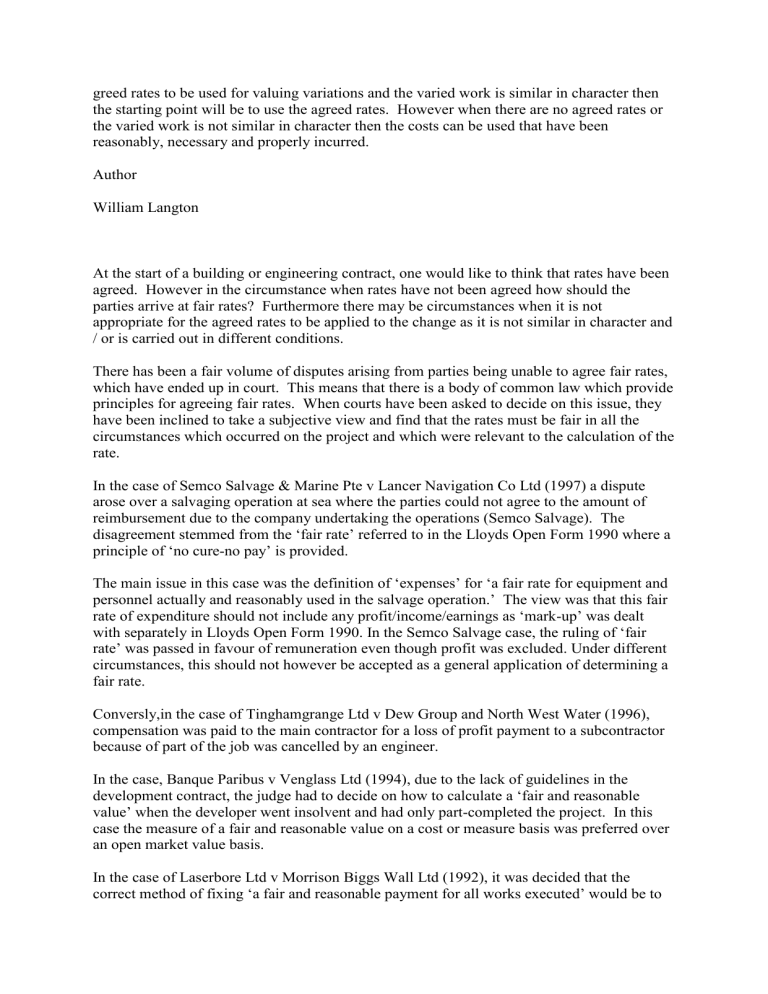
greed rates to be used for valuing variations and the varied work is similar in character then the starting point will be to use the agreed rates. However when there are no agreed rates or the varied work is not similar in character then the costs can be used that have been reasonably, necessary and properly incurred. Author William Langton At the start of a building or engineering contract, one would like to think that rates have been agreed. However in the circumstance when rates have not been agreed how should the parties arrive at fair rates? Furthermore there may be circumstances when it is not appropriate for the agreed rates to be applied to the change as it is not similar in character and / or is carried out in different conditions. There has been a fair volume of disputes arising from parties being unable to agree fair rates, which have ended up in court. This means that there is a body of common law which provide principles for agreeing fair rates. When courts have been asked to decide on this issue, they have been inclined to take a subjective view and find that the rates must be fair in all the circumstances which occurred on the project and which were relevant to the calculation of the rate. In the case of Semco Salvage & Marine Pte v Lancer Navigation Co Ltd (1997) a dispute arose over a salvaging operation at sea where the parties could not agree to the amount of reimbursement due to the company undertaking the operations (Semco Salvage). The disagreement stemmed from the ‘fair rate’ referred to in the Lloyds Open Form 1990 where a principle of ‘no cure-no pay’ is provided. The main issue in this case was the definition of ‘expenses’ for ‘a fair rate for equipment and personnel actually and reasonably used in the salvage operation.’ The view was that this fair rate of expenditure should not include any profit/income/earnings as ‘mark-up’ was dealt with separately in Lloyds Open Form 1990. In the Semco Salvage case, the ruling of ‘fair rate’ was passed in favour of remuneration even though profit was excluded. Under different circumstances, this should not however be accepted as a general application of determining a fair rate. Conversly,in the case of Tinghamgrange Ltd v Dew Group and North West Water (1996), compensation was paid to the main contractor for a loss of profit payment to a subcontractor because of part of the job was cancelled by an engineer. In the case, Banque Paribus v Venglass Ltd (1994), due to the lack of guidelines in the development contract, the judge had to decide on how to calculate a ‘fair and reasonable value’ when the developer went insolvent and had only part-completed the project. In this case the measure of a fair and reasonable value on a cost or measure basis was preferred over an open market value basis. In the case of Laserbore Ltd v Morrison Biggs Wall Ltd (1992), it was decided that the correct method of fixing ‘a fair and reasonable payment for all works executed’ would be to evaluate the costs. In this case the question of whether a company should pass the benefit of discount on to the customer was examined. Essentially it was decided that the meaning of ‘fair and reasonable payments for all work executed’ ought to be based on general market rates and not applying a cost-reimbursable method. A differing approach was taken in Weldon Plant Ltd v the commissioner for the new Towns (2000). The judge was of the opinion that it should be based on the reasonable costs of carrying out the work if reasonably and properly incurred. This approach excluded costs that would not have arisen by a reasonably competent contractor and under similar circumstances. Reference was made to Keating on Building Contracts and the factors to be included in the calculation of a fair valuation. It was held that the cost of labour, cost of plant, cost of materials, cost of overheads and profit should all be included in the calculation. In the case of Serck Controls Ltd v Drake and Scull (2000), Serck asserted that they were entitled to be paid a reasonable sum for the completed work, however it was held that payment should be based on normal and usual rates. However to deal with inefficiency and wasted cost, principles from the case Lachhani v Destination Canada (1996) were applied. A fair valuation was calculated after considering costs that were reasonably, necessarily and properly incurred. Essentially if a building contractor performs work that is substandard in any way or defective, the actual costs should be adjusted so that the owner will only pay what the building work is actually worth.

